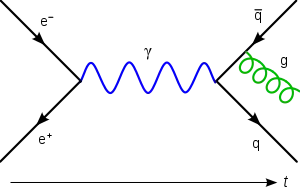Partition function (quantum field theory)
In quantum field theory, the partition function is the generating functional of all correlation functions, generalizing the characteristic function of probability theory.
| Quantum field theory |
|---|
 |
| History |
It is usually expressed by the following functional integral:
where S is the action functional.
The partition function in quantum field theory is a special case of the mathematical partition function, and is related to the statistical partition function in statistical mechanics. The primary difference is that the countable collection of random variables seen in the definition of such simpler partition functions has been replaced by an uncountable set, thus necessitating the use of functional integrals over a field .
Uses
The n-point correlation functions can be expressed using the path integral formalism as
where the left-hand side is the time-ordered product used to calculate S-matrix elements. The on the right-hand side means integrate over all possible classical field configurations with a phase given by the classical action evaluated in that field configuration.[1]
The generating functional can be used to calculate the above path integrals using an auxiliary function (called current in this context).
From the definition (in a 4D context)
it can be seen using functional derivatives that the n-point correlation functions are given by
Connection with statistical mechanics
The generating functional is the quantum field theory analog of the partition function in statistical mechanics: it tells us everything we could possibly want to know about a system. The generating functional is the holy grail of any particular field theory: if you have an exact closed-form expression for for a particular theory, you have solved it completely.[2]
Unlike the partition function in statistical mechanics, the partition function in quantum field theory contains an extra factor of i in front of the action, making the integrand complex, not real. This i points to a deep connection between quantum field theory and the statistical theory of fields. This connection can be seen by Wick rotating the integrand in the exponential of the path integral.[3] The i arises from the fact that the partition function in QFT calculates quantum-mechanical probability amplitudes between states, which take on values in a complex projective space (complex Hilbert space, but the emphasis is placed on the word projective, because the probability amplitudes are still normalized to one). The fields in statistical mechanics are random variables that are real-valued as opposed to operators on a Hilbert space.
References
- Matthew D. Schwartz, Quantum Field Theory and the Standard Model, 2013, Ch. 14
- Matthew D. Schwartz, Quantum Field Theory and the Standard Model, 2013, Ch. 14, p. 262
- Michael Edward Peskin, Daniel V. Schroeder, An Introduction to Quantum Field Theory, 1995, Ch. 9, p. 292
Further reading
- Jean Zinn-Justin (2009), Scholarpedia, 4(2): 8674.
- Kleinert, Hagen, Path Integrals in Quantum Mechanics, Statistics, Polymer Physics, and Financial Markets, 4th edition, World Scientific (Singapore, 2004); paperback ISBN 981-238-107-4 (also available online: PDF-files).